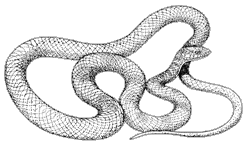Coachwhip
(Masticophis flagellum)
Order: Squamata
Family: Colubridae (colubrid snakes)
Other common name: red racer
Spanish names: chirrionero, alicantre
Description
This long, slender snake reaches lengths of 3 to 8¼ feet (90-260 cm) long. Quite variable in color, it can be tan, gray, pink, black, reddish-brown, or any combination of these colors. Broad crossbars may be present. The scales are smooth and the eyes large; the head is distinct from the body. Unlike the adults, young may have obvious dark brown or black blotches or bands on a light brown background. This snake receives its name from the braided appearance of its scales which resemble the whip used by stagecoach drivers in earlier days.

Range
This is a wide-ranging species occurring throughout the southwestern United States south through Baja California and Mexico (except the Sierra Madre).
Habitat
This common snake is found in deserts, prairies, grasslands, woodlands, thornscrub, and even cultivated lands. It is found from below sea level to 7700 feet (2350 m) in hilly or flat lands, rocky or sandy soils.
Life History
Active during the morning and late afternoon, the coachwhip is often seen crossing roads. A speedy snake, it has been clocked at 3.6 miles per hour. The coachwhip is a nervous snake and may retreat into rocks or rodent burrows when threatened, but it is just as likely to approach an intruder hissing, striking, and possibly shaking its tail; it will bite if handled. During summer 4 to 20 eggs are laid, hatching 44 to 88 days later. Young and adults feed on mammals, birds, bird and reptile eggs, lizards, snakes, carrion, and insects; the prey is seized and swallowed without being killed.










